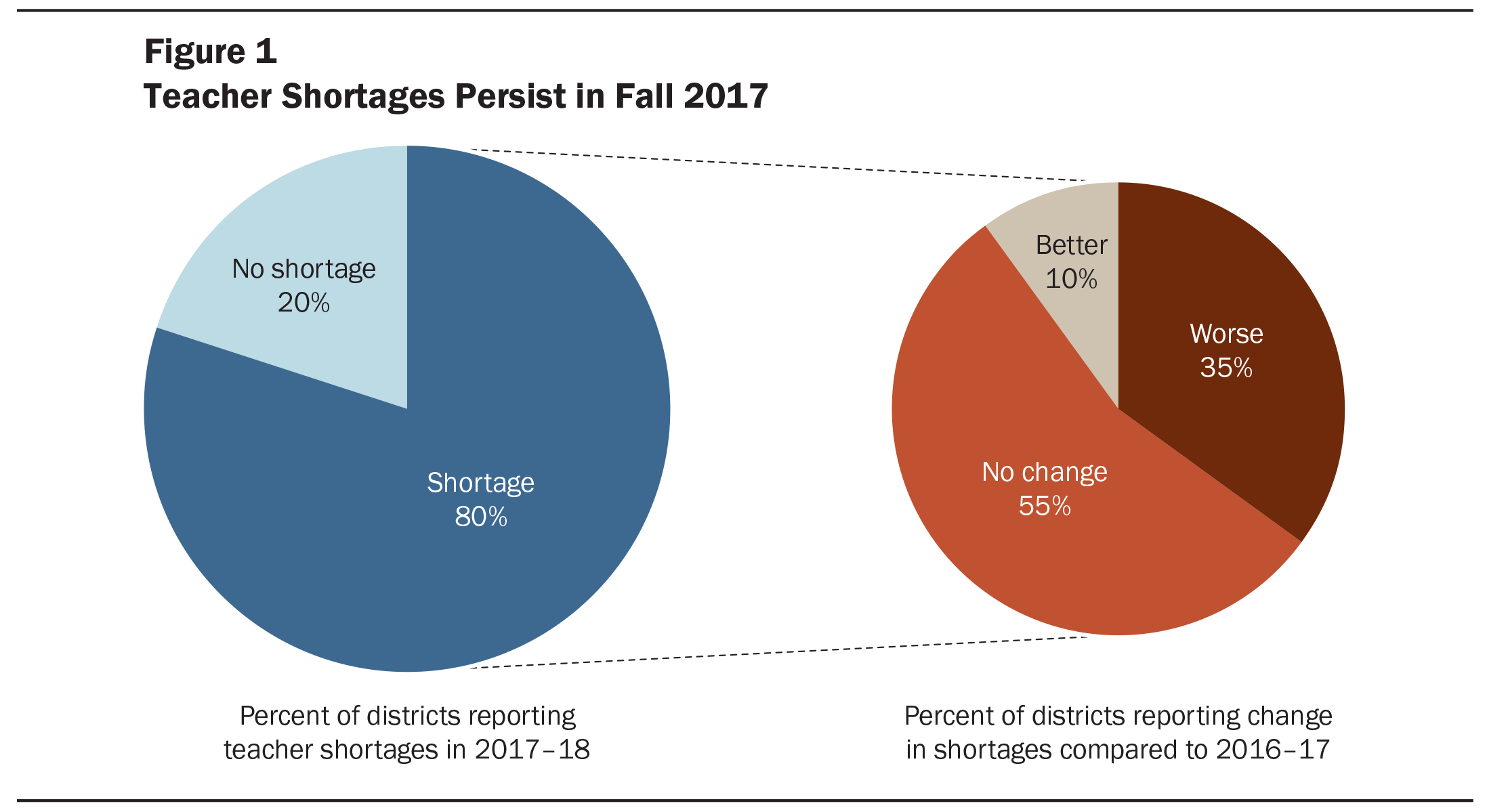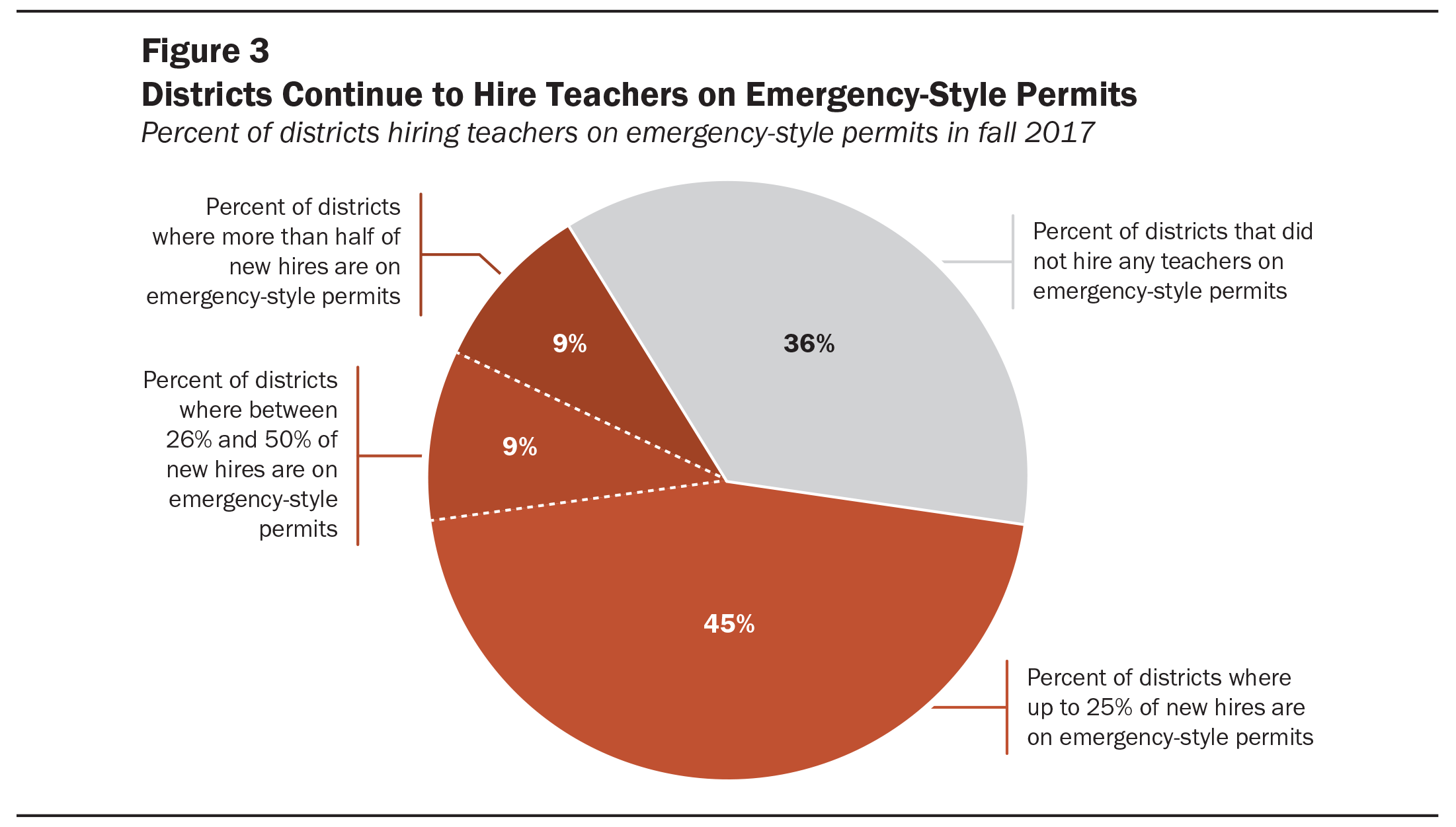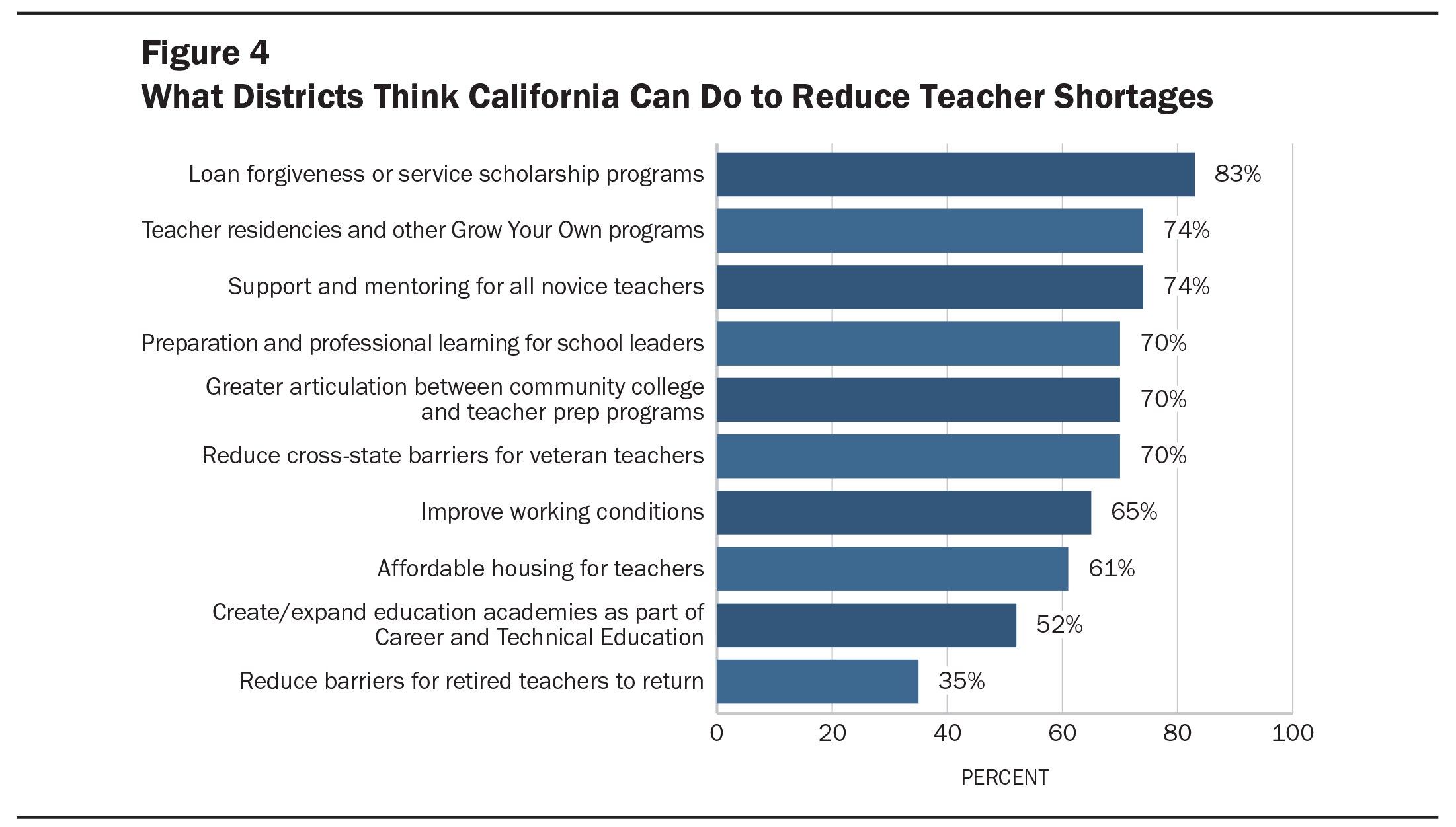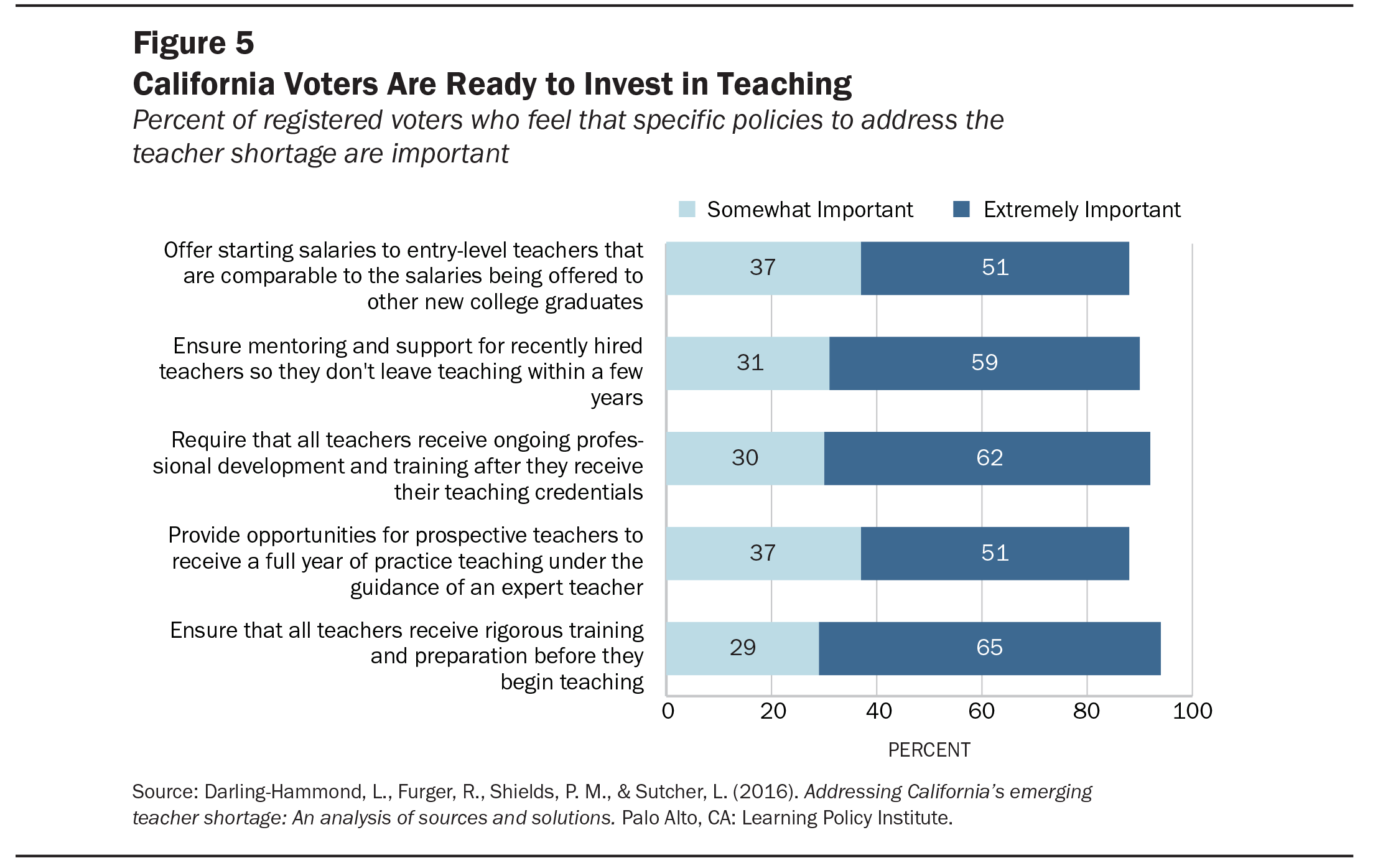Understaffed and Underprepared: California Districts Report Ongoing Teacher Shortages

Summary
To provide timely data to practitioners, policymakers, and other stakeholders, this brief examines how California districts experienced staffing difficulties in fall 2017. We surveyed 25 urban, rural, and suburban school districts that serve a quarter of students in the state. Fully 80% reported having a shortage of qualified teachers in 2017–18; 82% hired underprepared teachers, and nearly half hired a greater proportion of underprepared teachers than the year before. Although districts reported hiring slightly fewer teachers overall, a greater share of new hires hold substandard credentials, suggesting that shortages are persisting. District respondents support an array of policies to address California’s teacher shortage, most frequently pointing to loan forgiveness and service scholarships, teacher residencies and other Grow Your Own programs, as well as support and mentoring for novice teachers.
After many years of budget cuts and staff layoffs, the tide turned in 2013, when California began to bring new, more equitably distributed revenues into the education system as a result of Proposition 30 and the Local Control Funding Formula. As funding improved and districts began trying to replace the positions they had lost, teacher hiring increased dramatically. But qualified teachers were hard to find: The supply of new teaching candidates declined by more than 70% over the decade when jobs were not available.Darling-Hammond, L., Furger, R., Shields, P. M., & Sutcher, L. (2016). Addressing California’s emerging teacher shortage: An analysis of sources and solutions. Palo Alto, CA: Learning Policy Institute. As a result, since 2014–15, California districts have experienced acute shortages of teachers, especially in mathematics, science, and special education.Darling-Hammond, L., Furger, R., Shields, P. M., & Sutcher, L. (2016). Addressing California’s emerging teacher shortage: An analysis of sources and solutions. Palo Alto, CA: Learning Policy Institute; Podolsky, A., & Sutcher, L. (2016). California teacher shortages: A persistent problem. (Brief). Palo Alto, CA: Learning Policy Institute; Carver-Thomas, D., & Darling-Hammond, L. (2017). Addressing California’s growing teacher shortage: 2017 update. Palo Alto, CA: Learning Policy Institute. The passage of Proposition 58 reinstating bilingual education has triggered additional shortages of bilingual teachers. And career technical teachers have been in short supply.
California’s ongoing teacher shortage undermines its efforts to implement new standards, to improve learning, and to close achievement gaps. When districts cannot fill a position with a qualified teacher, they have no good options. California districts report dealing with shortages by hiring long-term substitutes or teachers with substandard credentials, leaving positions vacant, increasing class sizes, or canceling courses.Podolsky, A., & Sutcher, L. (2016). California teacher shortages: A persistent problem. (Brief). Palo Alto, CA: Learning Policy Institute. As districts increasingly rely on hiring teachers with little or no preparation, they incur academic and financial costs. Teachers without quality preparation leave the profession at two to three times the rate of fully prepared teachers,Podolsky, A., Kini, T., Bishop, J., & Darling-Hammond, L. (2016). Solving the teacher shortage: How to attract and retain excellent educators. Palo Alto, CA: Learning Policy Institute. creating a revolving door effect that makes shortages worse and negatively impacts student achievement.Ronfeldt, M., Loeb, S., & Wyckoff, J. (2013). How teacher turnover harms student achievement. American Educational Research Journal, 50(1), 4–36. Furthermore, the cost to replace teachers who leave can exceed $20,000 per teacher.Barnes, G., Crowe, E., & Schaefer, B. (2007). The cost of teacher turnover in five school districts: A pilot study. National Commission on Teaching & America’s Future; Milanowski, A., & Odden, A. (2007). A new approach to the cost of teacher turnover. Seattle, WA: School Finance Redesign Project, Center on Reinventing Public Education; Shockley, R., Guglielmino, P., & Watlington, E. J. (2006). A national crisis in teacher education: What are the costs? Old Tappan, NJ: Pearson Education; Learning Policy Institute. (2017). What’s the cost of teacher turnover? Palo Alto, CA: Author.
Shortages disproportionately impact students from low-income families and students of color, exacerbating persistent achievement gaps between these students and their more affluent peers. According to the state’s plan to ensure equitable access to teachers, filed with the federal government, teachers on emergency-style permits are three times as likely to teach in California’s high-minority schools and twice as likely to teach in high-poverty schools as in more advantaged schools.Torlakson, T. (2016, November 8). California state plan to ensure equitable access to excellent educators. (Memorandum). Sacramento, CA: California Department of Education.
Over the past 2 years, the legislature has enacted several initiatives to address the shortages, including designating $45 million to help classified staff become certified to teach; $10 million to start new undergraduate programs for teacher education; and $5 million to launch a Center for Teaching Careers, a recruitment and resource center for teaching candidates and those considering a teaching career. A key question is: Have these programs been enough to address the shortages, or does more still need to be done?
This brief examines how districts experienced teacher supply in the fall of 2017. The Learning Policy Institute surveyed 25 California school districts, including the largest suburban and urban districts in the state and a sampling of rural districts, representing every region in California.We surveyed 31 districts in total, choosing districts based on size and geographic representation. Our sample included the 15 largest districts in California. To ensure geographic diversity, we used the regional system of the California County Superintendents Educational Services Association, which divides California’s 58 counties into 11 “service regions." We included an additional large district in each of the five CCSESA service regions not represented by the 15 largest districts. To ensure representation from rural school districts, we also included the district that received the most federal Rural Education Achievement Program funding in 2016–17 in each CCSESA service region, for a total of 11 rural districts. We had an overall response rate of 81% (25 responses). All 11 CCSESA regions are represented by the 25 districts that responded to the survey. For five of the CCSESA regions, we received at least one response from a large district and a rural district; for four regions, we received responses from large districts only; and for two regions, we received responses from rural districts only. In all, these 25 districts serve over 1.5 million California students, a quarter of all students in the state.
California Teacher Shortages in 2017
This survey suggests that teacher shortages are still widespread and growing worse in many communities. Fully 80% of district respondents report experiencing a shortage of qualified teachers for the 2017–18 school year (see Figure 1). Of those districts reporting shortages, 90% report that they are as bad or worse than they were last year.Note: 24 of the 25 districts surveyed reported the severity of the shortage in relation to 2016–17. Only 10% say shortages have improved since 2016–17.

These results are consistent with districts’ experiences in the previous year. In a fall 2016 survey of 211 school districts that are part of the California School Boards Association’s Delegate Assembly—a sample that generally reflects the demographics of California’s districts—75% of districts reported having a shortage of qualified teachers at that time, with over 80% of these districts reporting that shortages had gotten worse since the 2013–14 school year.Podolsky, A., & Sutcher, L. (2016). California teacher shortages: A persistent problem. (Brief). Palo Alto, CA: Learning Policy Institute.
Teacher Shortages Affect Everyone in a School District
Student.
At the start of this school year, my classmates and I arrived in sociology class to find that a teacher hadn’t been assigned to the course. Every day during that first week, students would arrive in class ready to learn, only to find out that we still didn’t have a teacher. I ended that week feeling distraught. It felt like my education was being limited by something I didn’t have any control over.
—Jiawen Wang, 11th-grade student leader, Californians for Justice, Oakland Unified School District
Teacher.
In my district, we have 85 teachers right now who are either interns or … on special credentials; 45 of them last set foot in a classroom when they left high school. They have no teacher education experience. They have no pedagogical knowledge, outside of whatever they experienced as a student. So, when they come into our classrooms they don’t know classroom management [and] they don’t know the pedagogy of the subject that they’re teaching. They’re trying to survive, and we’re trying to help them as best we can.
—Linda Tolladay, Teacher and Instructional Coach in Science, Madera Unified School District
Principal.
My first year as principal, I opened the school year without a teacher for a special education class. It had a whole host of negative repercussions for staff and students. Running that special education class without a permanent teacher was a day-to-day crisis management situation. All of my responsibilities—meeting the needs of the parent community, supporting students, serving as the instructional leader, taking care of building management—were left to flounder because my primary concern was making sure one classroom was safe and functional.
—Daina Lujan, Principal, Meadows Elementary School, Millbrae School District
The Prevalence of Underprepared Teachers
In 2015–16, California issued more than 10,000 intern credentials, permits, and waivers, more than double the number issued in 2012–13. These substandard teaching authorizations can only be granted when fully credentialed teachers are not available, and are thus a key indicator of shortages.Carver-Thomas, D., & Darling-Hammond, L. (2017). Addressing California’s growing teacher shortage: 2017 update. Palo Alto, CA: Learning Policy Institute. In 2015–16, 2 out of 3 new special education authorizations and 2 out of 5 new mathematics and science authorizations were issued to individuals who had neither completed their training nor met California’s requirements for a preliminary teaching credential, which is the standard credential for a new teacher.Carver-Thomas, D., & Darling-Hammond, L. (2017). Addressing California’s growing teacher shortage: 2017 update. Palo Alto, CA: Learning Policy Institute.
Emergency-style permits—issued to individuals who have not demonstrated knowledge of the subject(s) they are teaching and who typically have not yet entered a teacher training program—have more than quintupled since 2012–13 and represent the fastest growing category of substandard teaching authorizations. In 2016–17, California issued just under 6,000 Provisional Intern Permits and Short-Term Staff Permits.California Commission on Teacher Credentialing. (2017, October). Program capacity survey.
Although most districts report decreases in vacancies and new hires between 2016–17 and 2017–18, 75% report they were unable to fill all their vacancies with fully credentialed teachers for this year.Note: 24 of the 25 districts surveyed reported whether they were able to fill all vacant positions with qualified teachers in 2017–18. After a spike in demand as districts refilled positions that had been cut during the Great Recession, demand for new teachers could be steadying. Even so, survey results suggest that teacher supply is still insufficient to meet demand. Districts in large urban and suburban communities, as well as those in rural communities, both report shortages (83% and 71%, respectively). Many districts resort to hiring underprepared teachers, who have not completed the requirements for full certification, when fully prepared teachers cannot be found. Indeed, 82% of districts hired underprepared teachers, and nearly half of districts report hiring a greater proportion of underprepared teachers this year than the year before.Note: 22 of the 25 districts surveyed reported whether they hired underprepared teachers in 2017–18, and 21 of the 25 districts surveyed reported sufficient data to determine the proportion of underprepared teachers in 2017–18 compared to 2016–17. In the districts that hired more underprepared teachers, the share of new hires who held less than a full teaching credential increased by about 30%, on average, compared to the previous year. In most districts hiring underprepared teachers, these teachers comprised up to a quarter of new hires (see Figure 2). And in a growing number of districts (14%), most new hires held substandard credentials or permits in fall 2017.

Even though districts are looking for fewer teachers overall, a greater proportion of their new hires are underprepared teachers, suggesting shortages persist.
Moreover, many districts are relying on the least prepared teachers to fill positions. Nearly two thirds of districts report hiring teachers on temporary permits and waivers, and half of those districts hired a greater proportion of teachers on these emergency-style permits this year than they did last year (see Figure 3).Note: 22 of the 25 districts surveyed reported whether they hired emergency-style teachers in 2017–18, and 21 of the 25 districts surveyed reported sufficient data to determine emergency credentials as a proportion of new hires in 2016–17 and 2017–18. In some small, rural districts, all new teachers were hired on emergency-style permits this year. In large districts, teachers on emergency-style permits made up as many as 30% of new hires. Interns, who are completing teacher preparation while teaching, also comprised up to 30% of new hires in some large districts.

State Policy Responses
District respondents report broad support for an array of policies to address California’s teacher shortage. Districts most frequently state that loan forgiveness and service scholarships, teacher residencies and other Grow Your Own programs, and mentoring support for novice teachers could be effective policies (see Figure 4). They ranked these as the top three ways the state can reduce shortages.

Loan forgiveness programs and service scholarships can help to recruit and retain high-quality teachers into the fields and schools where they are most needed. These approaches underwrite preparation in exchange for a number of years of service in the profession—often in particular high-need locations and subject areas. College students choose their professions in part based on whether their potential salaries can offset the higher education debt they will accumulate. With teachers earning about 30% less than other college graduates,Organisation for Economic Cooperation and Development “Table D3.2a. Teachers’ actual salaries relative to earnings of tertiary-educated workers” in OCED. (2015). Education at a glance 2017: OECD indicators. Paris, France: OECD Publishing. some who would like to teach eschew the profession because they cannot afford the costs of or debt associated with training. Service scholarships and forgivable loan programs have been found to be highly effective in recruiting individuals into teaching and directing them to the fields and locations with the highest need.Podolsky, A., & Kini, T. (2016). How effective are loan forgiveness and service scholarships for recruiting teachers? (Policy brief). Palo Alto, CA: Learning Policy Institute.
Most districts (83%) state that these financial supports can reduce teacher shortages. Similarly, in a fall 2017 survey administered by the California Commission on Teacher Credentialing, faculty of teacher preparation programs were most likely to identify a lack of financial aid for teaching candidates as the largest obstacle to increasing enrollment in their programs, rather than a lack of program capacity. In fact, many of the state’s teacher preparation programs—especially in shortage fields—receive far fewer applicants than they can accommodate.California Commission on Teacher Credentialing. (2017, October). Program capacity survey.
The now-defunct Assumption Program of Loans for Education (APLE) loan forgiveness program and Governor’s Teaching Fellowships provided teacher candidates between $11,000 and $20,000 in exchange for at least a 4-year commitment to teach in high-need schools and subjects. Program beneficiaries were more likely to teach in low-performing schools and had higher retention rates than the state average.Steele, J. L., Murnane, R. J., & Willett, J. B. (2010). Do financial incentives help low-performing schools attract and keep academically talented teachers? Evidence from California. Journal of Policy Analysis and Management, 29(3), 451–478; Podolsky, A., & Kini, T. (2016). How effective are loan forgiveness and service scholarships for recruiting teachers? (Policy brief). Palo Alto, CA: Learning Policy Institute.
Teacher residencies—1-year intensive apprenticeships modeled on medical residencies—consistently show higher retention rates, attract more diverse candidates, and target high-need subjects and locations.Guha, R., Hyler, M. E., & Darling-Hammond, L. (2016). The teacher residency: An innovative model for preparing teachers. Palo Alto, CA: Learning Policy Institute. Residents apprentice alongside expert teachers in high-need classrooms for a full academic year while completing coursework for master’s degrees at partnering universities. They typically receive a stipend and tuition assistance in exchange for a commitment to teach in the district for an additional 3 to 4 years after their residency. Such programs have been found to supply a diverse pool of effective teachers for high-need fields and dramatically reduce teacher attrition rates.Guha, R., Hyler, M. E., & Darling-Hammond, L. (2016). The teacher residency: An innovative model for preparing teachers. Palo Alto, CA: Learning Policy Institute. Nearly three quarters (74%) of districts believe these programs can reduce shortages, and the Governor’s January 2018 budget proposal calls for a major investment in teacher residencies for the training of special education teachers.California. Governor. (2018, January). Governor’s budget summary 2018-19.
Other Grow Your Own programs recruit, train, and support paraprofessionals, after-school program staff, and other local community members to teach in their own communities. The California Classified School Employee Teacher Credentialing Program, funded in 2016 and 2017, is supporting classified staff, such as paraprofessionals, to earn a bachelor’s degree and teaching credential. The program provides classified staff with $4,000 per year for up to 5 years (or $20,000 in total) to subsidize their teacher training costs. With a state investment of $45 million, the program has funded 2,250 slots. Nearly half of program participants are Hispanic or Latinx, and 5% are African American. Districts submitted grant applications requesting funding for more than 8,000 slots, suggesting there is significant unmet need.California Commission on Teacher Credentialing. (2017, December). Report to the Legislature on the California Classified School Employee Teacher Credentialing Program. Even though more than 2,000 teachers are entering the profession through this pipeline, it may take several years for them to complete a program.
Support and mentoring for novice teachers—also known as induction—can include coaching and mentoring; reduced workloads; collaborative planning time; extra classroom assistance; and a variety of other activities, such as seminars on critical topics. High-quality induction is associated with higher teacher retention rates and improved student learning.Podolsky, A., Kini, T., Bishop, J., & Darling-Hammond, L. (2016). Solving the teacher shortage: How to attract and retain excellent educators. Palo Alto, CA: Learning Policy Institute. All beginning California teachers are required to complete an induction program during their first 5 years of teaching in order to earn the California clear credential. However, targeted state funding for induction was folded into the Local Control Funding Formula, resulting in many districts reducing their support for new teachers, requiring new teachers to pay a fee for induction, or requiring new teachers to enroll at an institution of higher education to complete induction. Seventy-four percent of districts identify new teacher support and mentoring as a state policy that can reduce teacher shortages.
Districts identify several other state policies that can reduce teacher shortages, including:
- Investing in preparation and professional development for school leaders, including training in how to productively manage hiring and support for new teachers (70%)
- Providing incentives for greater articulation between community colleges and teacher preparation programs so that teacher candidates can begin their teacher training coursework and clinical training while enrolled in community college so that they can carry their credits into a college credential program (70%)
- Reducing barriers to entry for veteran teachers moving from other states through stronger licensure reciprocity and cross-state pensions or portable retirement benefit plans (70%)
- Offering incentives to schools to improve working conditions associated with job satisfaction and retention, such as providing time for teacher collaboration (65%)
- Providing support to create affordable housing for teachers (61%)
- Providing funding for districts to create or expand high school education academies as part of their career technical education programs (52%)
- Reducing barriers so that retired teachers can return to fill positions in high-need subjects and locations (35%)
Some federal funding under Title II of the Every Student Succeeds Act was allocated in 2017 to implement some of these initiatives through the California Educator Development (CalEd) competitive grant program. The program offers about $9 million in grants, of between $100,000 and $1.25 million, for local education agencies (LEAs) to focus on the development of school leaders or teacher recruitment and development, especially in shortage subjects.California Commission on Teacher Credentialing. (2017, December). Update on state-funded grant programs. The state also invested an additional $5 million in the Bilingual Teacher Professional Development Program to fund initiatives that increase the number of teachers with bilingual authorizations, a critical shortage area.Torlakson, T. (2017, September). Bilingual Teacher Professional Development Program, 2017 request for applications.
California voters support investments to mitigate teacher shortages. In a September 2015 survey of 1,001 registered California voters, 86% of respondents said the teacher shortage was a serious problem. Furthermore, overwhelming numbers of voters supported many of the same policy solutions as school districts, including loan forgiveness and service scholarships to incentivize new teachers to enter the field (85%) and mentoring and support for recently hired teachers to increase their retention (90%).Learning Policy Institute. (2016). Is the looming teacher shortage a serious problem? Should the state take decisive action? California voters say yes, according to recent poll. (Policy brief). Palo Alto, CA: Learning Policy Institute. And nearly 90% of respondents also supported an expansion of residency-type programs, which provide prospective teachers with a full year of practice teaching under the guidance of an expert teacher (see Figure 5).

California voters participating in the poll were equally clear about what they do not want to see happen as a result of the teacher shortage: They do not want students from low-income families to be taught increasingly by underprepared teachers. Nearly 9 in 10 respondents said it was a problem for public schools in low-income communities to have fewer qualified teachers than public schools in wealthier areas, and a majority felt that shortages should not be resolved by recruiting individuals who are not fully prepared—the very thing many districts have been forced to do in response to deep shortages across the state.
Conclusion
Over the past 2 years, California has invested nearly $70 million in curbing teacher shortages. These are important investments, but it will likely take 3 to 5 years before they make a substantial impact on the teacher supply in California. New 4-year teacher credentialing programs, for example, will just begin enrolling their first cohort of candidates in fall 2018.California Commission on Teacher Credentialing. (2017, December). Update on state-funded grant programs. Meanwhile, districts report that stubborn shortages in the state persist, and they respond by turning more and more to the least qualified teachers.
Districts suggest that high-retention pathways into the profession, such as service scholarships and teacher residencies, can address these immediate shortfalls without compromising on teacher quality. At the same time, ongoing support for California teachers and improved working conditions can help schools retain the teachers they have.
See the Appendix for more information.
Understaffed and Underprepared: California Districts Report Ongoing Teacher Shortages (research brief) by Leib Sutcher, Desiree Carver-Thomas, and Linda Darling-Hammond is licensed under a Creative Commons Attribution-NonCommercial 4.0 International License.
Research in this area of work is funded in part by the S. D. Bechtel, Jr. Foundation. Core operating support for the Learning Policy Institute is provided by the Ford Foundation, the William and Flora Hewlett Foundation, and the Sandler Foundation.
